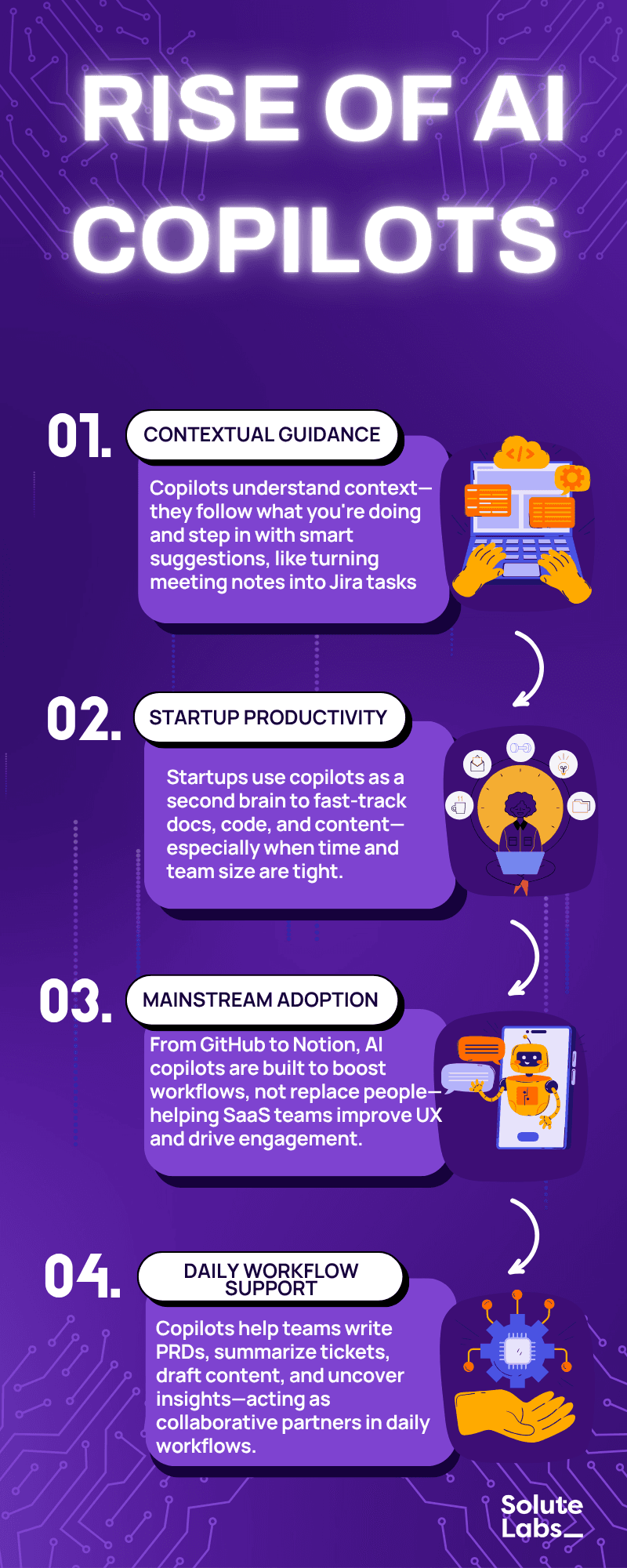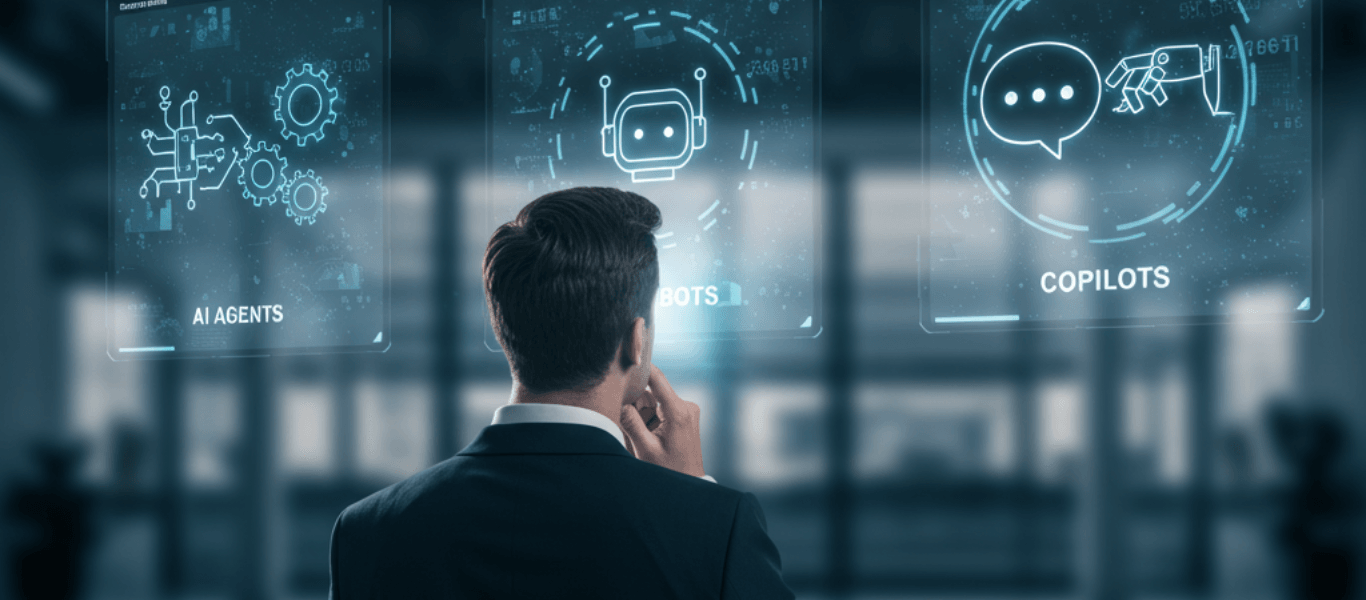In 2025, SaaS teams are flooded with AI tools that promise to speed things up, increase intelligence, and simplify workflows. But let’s be real, in terms like chatbots, copilots, and AI agents get tossed around so often, it’s hard to tell what sets them apart. And that confusion? It can hold your product back. The main question is what's the actual distinction between AI agents vs chatbots, vs copilots?
Almost 78% of SaaS businesses are incorporating some type of AI assistant in 2025, but not all tools are meant for the same thing. However, choosing the wrong one can result in lost opportunities, operational slowdowns, and a frustrating experience for your users.
In this blog, we’ll see what these tools do for SaaS teams, where they shine, fall short, and how to choose the right one to move your product forward. If you’re a SaaS founder, product owner, or engineering lead, this guide is made for you.
| AI Assistant | What is it for | Primary Role |
|---|---|---|
AI Agents | Used for doing tasks on their own | It makes decision-making easy for the users |
Copilot | Used for guiding users while they work | Provides smart suggestions and real-time support |
Chatbot | Used for answering common questions | Gives replies to user queries |
Scripted vs. Smart: How Chatbots are Changing?
If you’re introducing AI into your SaaS product, starting with a chatbot is often the first step. It’s a simple way to automate basic interactions like answering FAQs or routing support tickets, helping your team get into AI without overhauling your entire system. It can even help your users with basic questions, guide them through simple workflows, and even support onboarding. But here’s the thing: while chatbots are helpful, they often stay on the surface. They respond, but they don’t understand or do much beyond that.
1. Rule-Based vs LLM Chatbots
Old-school chatbots rely on scripted lines, imagine " the user saying X and the AI understanding Y." LLM-powered chatbots, on the other hand, use big language models to give more adaptable, human-like responses. However, modern-day LLM bots are more eloquent and wise, but still only function under the constraints provided by memory, context, and the ability to decide.
2. Basic Support Tasks
They excel in customer support situations, "How do I reset my password?" or "Where do I access invoices?" They reduced the ticket quantity but still require someone behind the scenes for more complex issues. At the core, it's all about function. You, as a user, enquire about something, and the bot answers it. It gets the job fully done. But let’s be honest: when it's helpful, it's far from groundbreaking.
3. First-Step Automation
Most SaaS applications utilize chatbots to give guidance to users during the onboarding. They provide sequenced hand-holding, tooltips, and auto-run tutorials. This works particularly well when you onboard hundreds of new customers each week, but the process is still linear and predictable.
4. Context Awareness
Chatbots usually handle one question at a time. They don’t remember the history of your questions or anticipate what you’ll need next. This becomes problematic in complex SaaS workflows where one question is often tied to another. They might be fluent, but not functional in different scenarios.
5. Rigid Functionality
A comparison of chatbots and AI assistants opens up a key drawback that chatbots lack: initiative. They rely entirely on user prompts and can’t perform multi-step tasks unless those flows are manually programmed, making them more rigid and reactive by design.
The Rise of AI Copilots in Modern SaaS Workflows

Nowadays, copilots in SaaS tools take your products to the next step. They’re not just sitting around waiting for commands; they jump in to assist, guide your next move, and simplify your workflow. Think of them as intelligent in-app partners that help to smooth tasks, offer timely suggestions, and free up your time to focus on what matters most.
1. Contextual Guidance
Copilots differ from chatbots since they're aware of context. They monitor what you're working on and provide relevant assistance. For instance, auto-suggesting Jira tasks from meeting notes. They can even summarise documents, anticipate next actions, and recommend improvements, tuning their behaviour by user interaction patterns.
Suggested Read
A Complete Guide to New GPT-5: Features, Tests, Benchmarks, and More
View Blog
2. Startup Productivity
Startups rely on copilots to accelerate documentation, meeting summarisation, marketing content generation, or coding. They change into a second brain for teams. It is particularly useful when teams are tight on time and small in size. A copilot can even spit out drafts, reports, or even complete product plans with limited input.
3. Mainstream Adoption
You’ve seen them: Google Docs’ Smart Compose, GitHub Copilot, Notion AI, and Jira Copilot are designed to accelerate workflows, not replace humans. Most major AI copilots in SaaS tools are already choosing copilots to drive stickiness, improve UX, and increase their user satisfaction metrics.
4. Daily Workflow Support
Product managers use copilots to write product requirement documents. They support agents to summarise tickets and marketers to draft copy. It’s collaborative AI, not just reactive AI. These copilots usually get deeply involved in the day-to-day workflow, exposing insights, creating ideas, and unloading brain cycles.
Why SaaS Teams Are Relying on AI Agents?
AI copilots aren’t just clever responders or friendly UI sidekicks. However, they are independent problem-solvers inside your product. While a chatbot might tell your user how to generate a report, generative AI copilots can do it via email and log it into your CRM, all without you or your team stepping in.
Additionally, unlike copilots that support human actions, agents take ownership of tasks from start to finish. They don’t just assist you in completing a goal, but they work towards it. Whether it’s handling lead routing, updating records, or notifying sales teams, agents operate behind the scenes to make it happen. No nudges required.
While copilots show up in the interface to guide your users, agents quietly drive automation underneath. For growing SaaS teams looking to scale without piling on manual processes, this is where the real impact of AI kicks in. You stay focused on the strategy, and along with it, your agent handles the execution.
From Responses to Results: AI Tools Working in Sync
Chatbots handle quick responses, copilots guide users through tasks, and agents quietly execute in the background. Together, they create a smooth AI-powered workflow that feels intuitive, quick, and scalable.
1. Chatbots for Basic Support
You’ll still find chatbots handling things like FAQs, password resets, and ticket routing and for good reason. They’re affordable, quick to set up, and a great way to dip your toes into automation. But here’s the catch: they only go so far. Once your users need more than just basic answers, you’ll likely need to step in manually. Chatbots are also a solid starting point, but they’re not built for depth or complex support.
2. Copilots for Knowledge Work
Marketers, product managers, and developers rely on copilots daily to summarise meeting notes, draft specifications, or even debug code, saving valuable time. Beyond productivity, copilots also improve user adoption by offering guided assistance within complex interfaces or tools that typically require heavy documentation.
3. Agents for Process Automation
From onboarding workflows to lead scoring and billing operations, agents do the backend grunt work consistently and alone. They integrate APIs, choreograph decisions, and build smooth workflows that don't require daily care.
A fast-growing SaaS CRM was facing drop-offs during onboarding, relying on a limited rule-based chatbot. By switching to an autonomous AI copilot, they automated multi-step flows and adapted to real user behaviour. The result? Onboarding tripled, support load dropped by 40%, and conversions jumped by 28%. The right AI assistant doesn’t just respond, it evolves with your product.
Is Your SaaS Ready for What Users Will Expect Next?
Soon, users won’t settle for basic support; they’ll expect your SaaS product to understand their intent, offer smart suggestions, and handle tasks without being told what to do. If you’re still relying on simple chatbots, there’s a risk your product may feel outdated while competitors move ahead with more intelligent solutions.
People will naturally gravitate toward platforms that save them time, reduce effort, and feel intuitive. AI agents vs chatbots will become the norm, quietly improving everything from onboarding to customer retention. The difference? These tools don’t just respond, they evolve with your users, learning and adapting along the way.
So, the real question isn’t if AI should be part of your product, it’s how soon. Your decisions today will define how competitive and scalable your SaaS is tomorrow. The future belongs to products that are not just powered by AI, but intelligently designed around it.
Conclusion
AI isn’t just a feature anymore; it’s becoming the foundation of how great SaaS products are built and scaled. Choosing the right AI assistant in the race of AI agents vs chatbots shapes your user experience, operational quickness, and long-term growth.
At SoluteLabs, we don’t just help you plug in AI; we help you build it from the ground up. By building on strong data foundations, reliable infrastructure, advanced models, ethical practices, and continuous learning, you’re not just keeping your product up to date; you’re setting it up to lead the way in a fast-moving, AI-driven future.
If you’re aiming to build a future-ready SaaS platform with intelligence at its core, now is the time to start. Book a consultation and explore what it holds for you.







